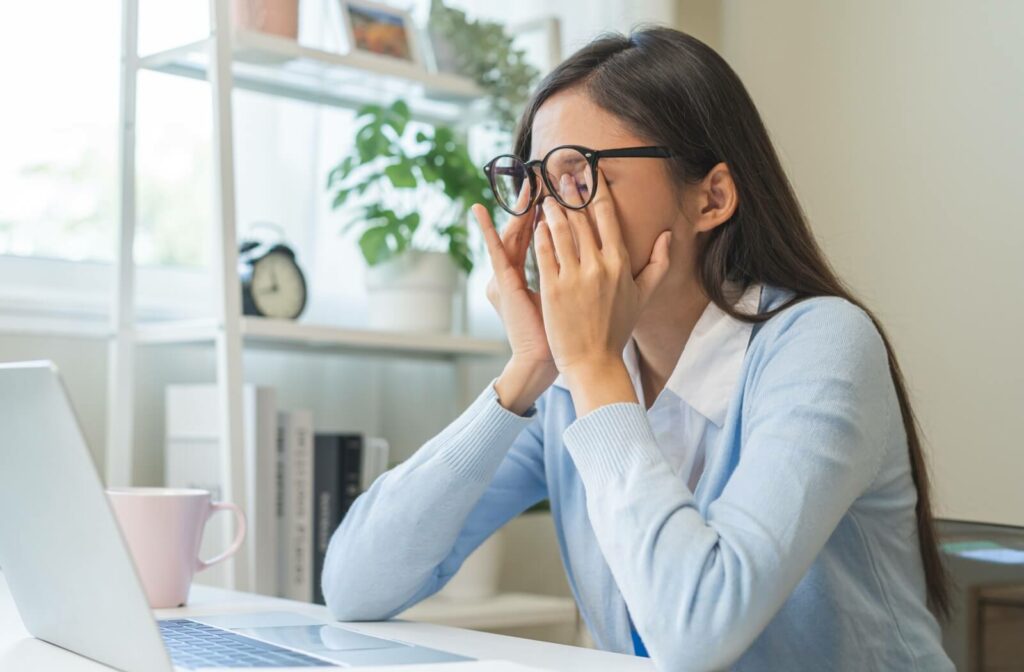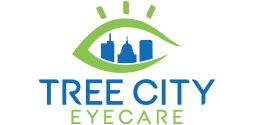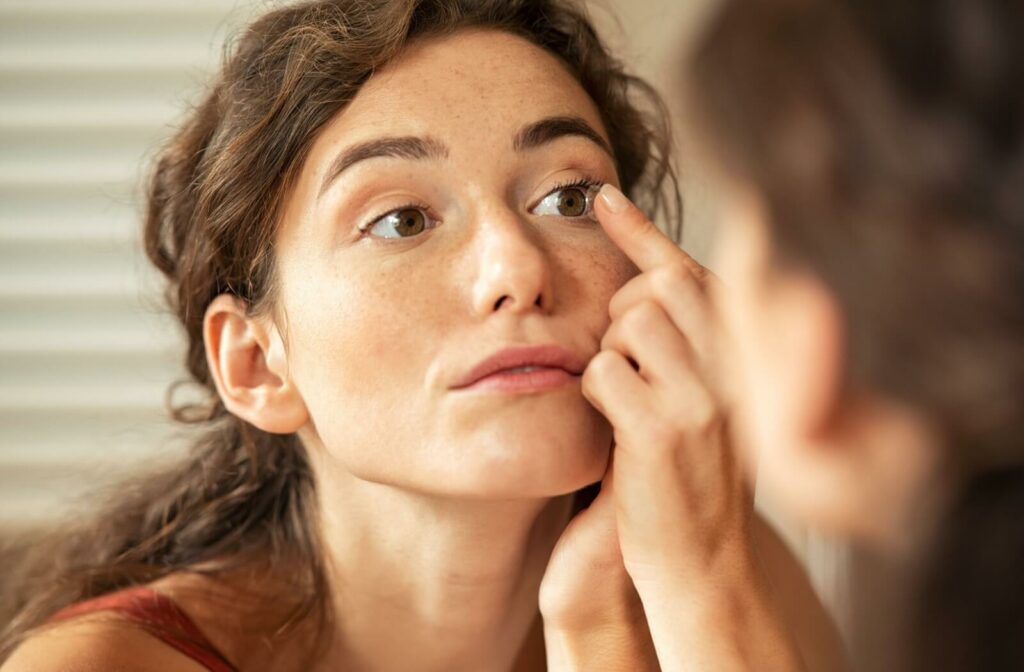Those who suffer from dry eyes are well aware traditional contact lenses can exacerbate dry eye symptoms. To maintain comfort, you likely continue wearing your eyeglasses.
Fortunately, scleral contact lenses’ unique design allows the eye’s surface to maintain moisture, making them a great option for dry eye sufferers.
What are Scleral Contacts?
Scleral contact lenses are oversized, specialized hard contact lenses that resemble small, snug bowls. They create a protective barrier over the eye, providing a continuous supply of moisture which offers a unique solution for individuals with vision problems who find traditional lenses uncomfortable or ineffective.
Scleral lenses work by creating a new, smooth optical surface that corrects vision issues while protecting the cornea.
Scleral lenses are designed to sit on the sclera, rather than the cornea like traditional contact lenses, leaving the cornea shielded by a reservoir of liquid. The fluid-filled space between the lens and the cornea acts as a cushion, providing continuous hydration to the eye.
Scleral lenses work by creating a new, smooth surface that corrects vision issues while protecting the cornea. This unique design allows them to address specific eye conditions while providing clear, comfortable vision.
Scleral lenses are particularly beneficial for people with:
- Severe dry eyes
- Irregular corneas
- Keratoconus
- Post-surgical complications
Understanding Dry Eyes
Dry eye disease is a common chronic condition where your eyes don’t obtain the required moisture to keep the eye’s surface lubricated. It refers to the dry, gritty, almost burning sensation that individuals may experience on their eye’s surface.
The severity of dry eyes can range from a mild annoyance to a serious issue impacting daily activities and overall quality of life. While many experience periodic dry eye symptoms, for some, it can lead to more significant complications, including eye infections or damage to the cornea if left untreated.
The sensation of dry eyes can vary between individuals; common symptoms include:
- Redness
- Burning
- Blurry vision
- Gritty or sandy feeling in the eye
- Feeling as if there’s something in the eyes
- Excessive tearing to compensate for dryness
There are two main types of dry eye disease:
- Aqueous Tear-deficient Dry Eye: Where the body does not produce sufficient tears to maintain a healthy eye surface.
- Evaporative Dry Eye: Where deficiencies in the oil glands along the eyelids reduce necessary oil secretion to prevent tear evaporation, resulting in tears evaporating too quickly from the eye’s surface.
Dry eyes can develop from several factors, including:
- Certain medications
- Environmental factors
- Prolonged screen time
- Tear gland dysfunction
- Prolonged contact lens wear
Understanding which type of dry eye you have is important because it helps discern the appropriate treatment necessary to provide long-term relief.
For example, someone with aqueous-deficient dry eye may benefit from artificial tears or medications to stimulate tear production. In contrast, someone with evaporative dry eye may find better relief using therapies that help unclog oil glands, like a warm compress.
Having dry eyes can lead to various adverse effects on both eye health and vision. When tear production is insufficient or of poor quality, it can result in inflammation and irritation of the surface of the eye, leading to discomfort and a persistent feeling of dryness.
Therefore, managing dry eyes is necessary not only for comfort but also for preserving long-term eye health and good vision.

Why Scleral Contacts are Suitable for Dry Eyes
Unlike traditional contact lenses, which can exacerbate dry eyes by sitting directly on the cornea, scleral lenses vault over the cornea, creating a fluid-filled reservoir that keeps the eye hydrated.
This larger size allows them to provide more stability and comfort, especially for those with irregular corneas or severe dry eyes.
By vaulting over the cornea and resting on the sclera, these lenses form a fluid reservoir that continuously hydrates the eye while also providing a barrier against environmental factors that can dry out the eyes.
Plus, the larger diameter of the lens confirms that it covers the entire corneal surface, which helps retain moisture and reduces lens movement during blinking, enhancing comfort and providing a more secure fit.
Through these features, scleral contact lenses provide ample hydration for those with dry eyes who have not found relief with other types of contact lenses or dry eye treatments.
Wearing traditional contact lenses can be uncomfortable for those suffering from severe dry eyes. Traditional contact lenses rest directly on the cornea, which can exacerbate dryness and irritation by limiting the flow of oxygen to the eye and preventing the natural tear film from stabilizing.
Wearing these contacts can increase discomfort, redness, and irritation, making it challenging to wear for extended periods. Plus, traditional lenses can absorb tear moisture, further drying out the eye’s surface. When eyes are seriously dry the lenses can stick to the corneal surface. Therefore, traditional contact lenses aren’t ideal for those with severe dry eyes.
Fortunately, scleral contacts provide a comfortable, hydrating solution to this problem, meaning dry eye sufferers can still benefit from a hands-off approach to vision correction.
Schedule a Consultation with Us
For those struggling with dry eyes, traditional contact lenses aren’t providing the relief you need. Scleral contact lenses may be the solution you’ve been looking for.
Connect with our team at Tree City Eyecare to schedule a contact lens fitting to learn more about your compatibility with scleral contact lenses.


